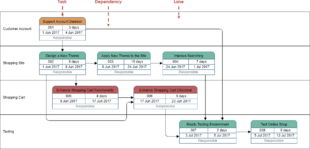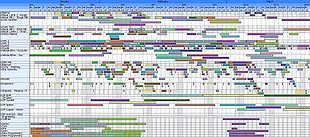Scheduling: Critical path, PERT and Gantt
Developed by Frank Almirudis, currently under construction
Title to be changed to: Choosing critical path, PERT or Gantt as your project scheduling method
Contents |
Abstract
Under the aspect of Complexity in project management, Scheduling is the development and control of a plan which details when and how the products or services defined in a project scope will be delivered. [1][2]
The resulting plan is known as a project schedule, which can also be used as a tool for management of stakeholders' expectations, means of communication and/or evaluating performance. Project data like planned dates, activities, resources, constraints, dependencies and activity sequence and duration are all inputs to the project schedule, and should be constantly monitored and updated by the project management team. To properly create and use the project schedule with the aforementioned inputs, the team must select the scheduling method that best suits the needs of their project.
Three scheduling methods are covered in this article:
- Critical path method (CPM)
- Program evaluation and review technique (PERT)
- Gantt
The focus of this article is to help the reader:
- Know the definition, theory and purpose behind each scheduling method.
- Understand under what circumstances each method is best applied.
- Decide which scheduling method fits their case best.
- Understand the limitations of their selected method.
- Reference the reader to different sources on how to apply their selected method.
Scheduling methods


Critical Path Method (CPM) is a technique created to identify the key activities that are critical for the completion of a project, bearing in mind that if any of these were to be delayed, then the whole project delivery would be delayed. The end game of this method is to find and optimal balance between the length of the project and it's associated costs, as well as identifying the costs of the activities are minor according to the optimal time. In order to create a critical path diagram, one must at least consider all the activities that are requied to deliver the project, their duration and their dependencies. As these components are similar to the ones used in PERT, the two methods are often used together and their combination is called PERT/CPM.
Program evaluation and review technique (PERT) is a scheduling method aimed to create a project's timeline in a graphical manner. This timeline helps the user monitor and control the project's activities while ensuring that the interdependencies between said activities are kept in check and complied to in order to deliver the project. While activities are the central component of PERT, they are not scheduled, this is because the interdependencies dictate when an activity is able to be completed, as all other activities preceding it must be fulfilled before the next activity may be done. PERT diagrams are integrated by 4 key elements: Activities, preset date, calendar and contrains.
- Activities are sets of errands that are to be done to complete the project, these should have a completion time and a description.
- Preset date are set to the activities that may critically affect the delivery, and these dates are aimed to be respected.
- Calendar of working and non working days to accurately respresent the time when this project is to be completed.
- Constrains to set the interdependencies of the activities, these contratins can be: finish-to-start, finish-to-finish, start-to-start or finish-to-finish.
The timeline using PERT is usually represented by using two methods: Activity On Arrow (AOA) in which each activity is represented by arrows, while nodes are starting and finishing events of the activities. The other method is Activity On Node (AON) where activities are repesented as nodes while the arrows are the interdependencies of the activities. Note that an activity may not be started until all preceding connected activites are fulfilled.
Gantt chart is a visual representation that showcases tasks, ther dependecies and time constrains that allow project managers to identify challenges, control them and come up with different solutions to said challenges. using vertical and horizontal axis to represent a simple timeline for a project. The horizontal axis indicates the time available in a project, while the vertical axis represents the different tasks that need to be performed to do a project in the expected time delivery. Dependencies within each activity can be set as well in this method, however, because of how the visual representation is done in this particular method, adding too many dependencies may generate visual clutter, which can cause confusion to the viewer.
Best suitable method for particular cases
To properly assess if one should use PERT/CPM or Gantt for scheduling their project, the project management team must consider a number of indicators regarding the project. These indicators help the team understand where their project stands in a different number of fronts, and by understanding the project's priorities they can decide in a more objective way which method to use.

Complexity
The first and most important indicator to take into account is complexity of the project. The number of activities and the level of dependency between said activities will be in most cases the deciding factor in choosing between PERT/CPM and a Gantt chart. While a Gantt chart is a tool which almost anyone can use to generate a project schedule and it's easy to follow, when the activities and their dependencies start to pile up the Gantt chart gets too complex and it's hard to read and follow, losing the most fundamental advantage of the Gantt diagram over PERT/CPM, Figure 3 showcases an example of a Gantt chart used in a situation where the activities and dependencies were too many. An example on complexity can be seen in the Engineering, Procurement and Construction (EPC) process of a thermal power plant. Because of the level of detail that the EPC contractor has to look into in order to deliver a thermal power plant, they are likely to use PERT/CPM to monitor the various dependencies within the project, where as suppliers of specific equipment for the power plant (e.g. a pump manufacturer) will be more inclined to use a Gantt chart, due to the fewer steps in getting a single piece of equipment manufactured. The bottom line is: If the project management team considers that their project is simple enough in terms of activities and dependencies then a Gantt chart should be considered. If the complexity is too high for a Gantt chart, then the reader should consider using PERT/CPM, taking into account the below indicators as well to ensure that they are getting what they want out of their project schedule.
Resources available to generate and update the diagrams
Need for flexibility
Personnel to generate the diagram Software Time
Stakeholders who will need to read the schedule
Who can read it Need to use as a communication tool
Dependencies clarity
Timeframe
Resource allocation
Limitations
Application
References
- ↑ Project Management Institute, Inc. Guide to the Project Management Body of Knowledge (PMBOK® Guide). 2017. Chapter 6, page 175. Retrieved from https://app.knovel.com/hotlink/toc/id:kpGPMBKP02/guide-project-management/guide-project-management
- ↑ Practice standard for scheduling
- ↑ Made by Visual Paradigm Online.
- ↑ Made by Jeanette Garst Johansen September 2016.
- ↑ Google.com (2016), Google Pictures,web:http://1.bp.blogspot.com/-_7g6MG6XDYw/T4VTUS5h_LI/AAAAAAAAACM/NfzixKRsXbk/s1600/PanklGanttChart.JPG